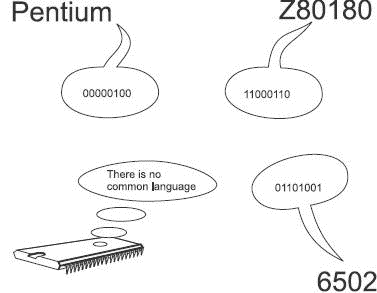Книга: Introduction to Microprocessors and Microcontrollers
9. Programming – using machine code and assembly
9. Programming – using machine code and assembly
We can use a microprocessor as part of a computer or as part of a dynamite process controller and the only essential difference is in the instructions that it is given.
Since the microprocessor has no intelligence at all, it relies entirely on following a sequence of instructions as we discussed in the fetch-execute cycle.
If you were sitting in a lecture theatre and the speaker said, ‘We’ll finish now’, you would know that it was time to pick up your bits and pieces and leave the room. Those words were not the only possibility, other instructions would have served the same purpose like, ‘Right, that’s it, thank you’; ‘We’ll break here’; ‘It seems a good time for a break’; ‘We’ll stop at this point and continue at the next session’, and many other variations. Teachers can clear a whole classroom instantly just by looking at their watch and saying, ‘Well, …’. There are literally dozens of ways of telling people that it is time to leave a room even before resorting to the less polite possibilities.
Microprocessors, on the other hand, have nothing like this degree of flexibility, in fact they have almost no flexibility at all. It is very frustrating, but we do not share any common language with a microprocessor (Figure 9.1). Each microprocessor has a built-in list of instructions that it can understand. This list is called its ‘instruction set’ and may consist of about a hundred or so instructions which must be put together in the right order to carry out the function required. This is the job of the programmer and is similar to a builder, constructing a house by putting a lot of simple pieces like wood, tiles, bricks in the correct order. When the microprocessor is designed, the instruction decoder recognizes these inputs and starts an internal process that allows the microprocessor to carry out the instruction. This presupposes that the microprocessor is familiar with the instruction or, to put it another way, the instruction is in a language that is understood by that particular microprocessor.

Figure 9.1 A small communication problem
As we have seen, we cannot talk directly to a microprocessor and, even worse, microprocessors often cannot talk directly to each other (Figure 9.2). This is particularly the case when the microprocessors have been developed by rival organizations.

Figure 9.2 They are all saying ‘ADD’
Within one company, such as Intel, there is a commercial pressure to ensure that each succeeding microprocessor understands the binary codes of the previous designs. This is referred to as being ‘upward compatible’. There is nothing to prevent a company from designing a microprocessor that has the same pins and programming capability as another. The Z80180 for instance was designed as an updated copy of the Intel Z80 which, in turn, was a revised version of the 8080A. It was a pin for pin compatible plug-in replacement. This may be irritating for the original designers but is accepted provided the internal design has not been copied. Indeed, it often does the original company no harm. If several compatible microprocessors are being sold it will induce many programmers to write programs using this code. This will increase the sales of these microprocessors and, perhaps, no-one will suffer.
The Intel Pentium was under similar attack during 1997/8 from other microprocessors like the Athlon series made by A.M.D. These can run Pentium programs and, for some purposes, are superior to the Pentium.
- Системные переменные ROWS_AFFECTED, GDSCODE, SQLCODE, TRANSACTIONJD, CONNECTIONJD
- Разработка приложений баз данных InterBase на Borland Delphi
- Open Source Insight and Discussion
- Introduction to Microprocessors and Microcontrollers
- Chapter 6. Traversing of tables and chains
- Chapter 7. The state machine
- Chapter 8. Saving and restoring large rule-sets
- Chapter 11. Iptables targets and jumps
- Chapter 5 Installing and Configuring VirtualCenter 2.0
- Chapter 16. Commercial products based on Linux, iptables and netfilter
- Appendix A. Detailed explanations of special commands
- Appendix B. Common problems and questions




